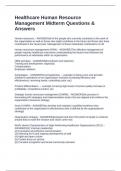Healthcare Human Resource
Management Midterm Questions &
Answers
Human resources: - ANSWERSall of the people who currently contribute to the work of
the organization as well as those who might contribute in the future and those who have
contributed in the recent past. Management of these individuals contributions is HR
Human resources management (HRM): - ANSWERSThe effective management of
people requires healthcare executives understanding the factors that influence the
performance of individuals within an organization.
HRM activities: - ANSWERSRecruitment and selection,
Training and development, Appraisal,
Compensation,
Employee relations
Advantages: - ANSWERSCost leadership → example is being a low-cost provider
(related to operations of an organization; includes increasing efficiency and
effectiveness, removing waste, controlling costs, etc)
Product differentiation → example is having high levels of service quality Increase in
profitability, competitive product, etc.
Strategic human resources management (SHRM): - ANSWERSthe process of
formulating HR strategies and implementation tactics that are aligned and reinforce the
organization's business strategy.
Goal of SHRM - ANSWERSto develop and maintain a qualified workforce that
contributes to the organization's effectiveness (this is defined by the organizational
strategy)
Organization strategy - ANSWERSdeveloped and then HR (which is liquid) is centered
around that to make the mission and vision come true.
Wolf's Seven Characteristics of High-Performing Healthcare Organizations (2012): -
ANSWERS(1) Visionary leadership
(2) Consistent and effective communication
(3) Selecting for fit and ongoing development of staff
(4) Agile and open culture
(5) Central focus on service
(6) Constant recognition and broad community outreach
,(7) Solid physician/clinical relationships
Environment has a significant impact on the function of HR: three major challenges
within the next ten years are - ANSWERS(1) retaining and rewarding the best
employees,
(2) developing the next generation of corporate leaders, and
(3) creating an organizational culture that attracts the best employees.
Implementation - ANSWERSis the major difficulty in the overall management process →
due to the lack of identification, diagnosis , and management of key stakeholders.
External stakeholders - ANSWERSpatients and their families, public and private
regulatory agencies, and third-party payers (insurance)
Interface stakeholders (both internal and external) - ANSWERSmembers of the medical
staff who have admitting power or those who are board members at multiple institutions.
Internal stakeholders - ANSWERSoperate within the organization (ex. managers)
SHRM Model: - ANSWERSOrganizations are moving towards higher levels of flexibility,
collaboration, decentralization, and team orientation. This is driven by environmental
changes and the organizational responses to those changes.
Benefits of SHRM to organization/stakeholder: - ANSWERSpositive behavior,
clear communication or organization goals,
stimulation of critical thinking and continual examination of assumptions,
identification of gaps between the current and future vision,
engagement of line managers,
identification of HR constraints and opportunities,
and creation of common bonds.
Internal and External Environment Assessment: - ANSWERSHRM involves giving
attention to the effect of both internal and external environment.
Organizational mission corporate strategy (SWOT is step one): - ANSWERSThree basic
levels:
corporate level - ANSWERSset of strategic alternatives that an organization chooses
from as it manages its operations at the same time across multiple industries and
markets.
business level - ANSWERSset of strategic alternatives that an organization chooses
from to most effectively compete in a particular industry or market.
functional level - ANSWERSstrategy that considers how the organizational will manage
each of its major functions.
, Staffing strategy: - ANSWERSrefers to a set of activities used by the organization to
determine its future HR needs, recruit qualified applicants with an interest in the
organization, and select the best of those applicants as new employees. Undertaken
only after a thorough development of corporate and business strategies.
Development strategy: - ANSWERShelps the organization enhance the quality of its
human resources.
Must be consistent with corporate and business strategies
Compensation strategy: - ANSWERSmust complement the organization's other
strategies.
Managers must account for other key parts of the organization including organizational
design, corporate culture, technology, and the workforce.
Organizational design: - ANSWERSrefers to the framework of jobs, positions, groups of
positions, and reporting relationships among positions.
Flat or horizontal approach is being more prevalent - ANSWERSdesigned to be flexible,
adaptable, streamlined, and empowered.
Corporate culture: - ANSWERSrefers to the set of values that help members of that
culture understand what they stand for, how they do things, and what they consider
important.
- ANSWERS
Traditionalists - ANSWERSborn 1929-45 and are disciplined and hardworking, but don't
do well when dealing with conflicts.
Baby boomers - ANSWERSborn 1946-64 and want to change the world, believe in hard
working and giving things up for success, entitled, strong values in health, wellness,
personal growth, and diversity.
Generation X - ANSWERSborn 1965-81 and first generation predicted to earn less than
parents, value work-life balance, some level of comfort with tech, value individualism
and flexibility.
Millennials - ANSWERSborn 1982-99 and grew up with most tech changes, high
confidence, used to instant feedback, willing and effective in teams, social media is a
major part of their lives.
HR metrics: - ANSWERSmeasures of HR outcomes and performance




